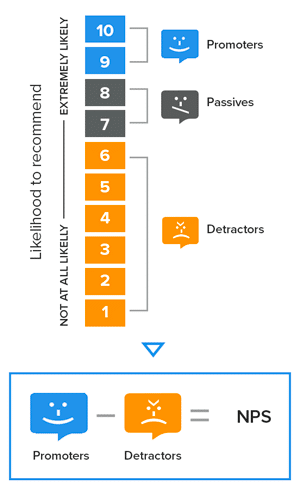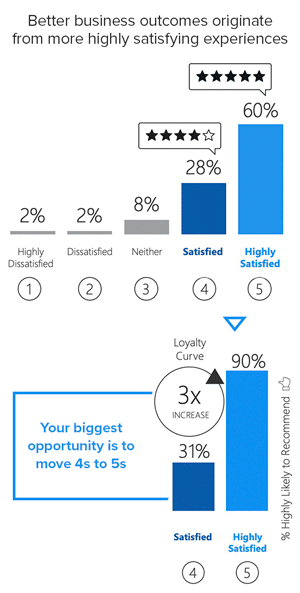What role Net Promoter Score should play in measuring the customer experience (+ answers to your other most pressing NPS questions)
Published on Apr 06, 2021

Net Promoter has long been a hot topic for businesses trying to improve the customer experience. Its popularity is tied to its simplicity and the assertion that a brand’s Net Promoter Score (NPS) is the most important predictor of brand health and future financial performance. But despite its appeal, NPS may not be the end-all-be-all metric for every brand.
In the November 2020 article NPS Benchmarks 2020: National Park Service, USAA, Trader Joe’s, And Navy Federal Top The Ranking, Forrester states, “NPS is a loyalty metric, not a direct measure of CX quality. It is only effective at improving CX when it’s part of a CX measurement and improvement system that measures the performance of your customers’ journeys.”
Deciding the right metric(s) for your brand requires exploring the Net Promoter concept in more detail and having a clear understanding of your brand’s culture and goals. This blog answers some frequently asked questions about Net Promoter, discusses the strengths and weaknesses of the Net Promoter approach, and includes our recommendations for incorporating Net Promoter components into your customer experience management program.
What is Net Promoter Score (NPS)?
Net Promoter Score is typically based on a question that asks consumers how likely they are, on an 11-point scale of 0–10, to recommend a company’s products or services to a friend or colleague. Ratings on this question are then divided into three categories:
- Promoters (those likely to recommend; 9s and 10s on the 11-point scale)
- Detractors (those unlikely to recommend; 0–6 on the 11-point scale)
- Passives (those neither likely nor unlikely to recommend; 7s and 8s on the 11-point scale)
Net Promoter Score is simply the percent of promoters minus the percent of detractors.

What is the logic behind Net Promoter Score?
The logic behind NPS is that promoters generate positive word of mouth that helps a brand acquire new customers, and detractors generate negative word of mouth that leads to customers avoiding the brand. Since having more promoters than detractors is good for business, the higher the NPS, the better.
What is the Net Promoter System?
The Net Promoter System is a philosophy and set of practices centered around measuring whether brands are treating customers in a way that leads to long-term growth and “good profits” or short-term revenue gain at the expense of long-term growth (“bad profits”). A Net Promoter System contains three critical components:
- It measures and categorizes customers as promoters or detractors
- It puts feedback in the hands of employees and enables them to implement “close the loop” processes with dissatisfied customers
- It creates a culture that makes customer loyalty a priority by sharing customer feedback and celebrating loyalty champions
Is Likelihood to Recommend always the best option?
The rationale of promoters versus detractors is best organized around the Likelihood to Recommend question, but some research shows this is not the best question for all businesses. In some cases, measures such as Overall Satisfaction or Intent to Return can be used as the basis for a promoter score as long as companies systematically categorize promoters and detractors.
Is a Net Promoter Score survey always a short survey?
NPS lends itself to a shorter survey but is not synonymous with one. NPS was originally introduced as a remedy to long customer experience surveys. In the DNA of the NPS measure is the belief this single question, followed by an open-ended question asking customers to explain their rating, can provide enough useful feedback to improve the customer experience. NPS advocates also believe longer surveys are likely to reduce representativeness because many customers are unwilling to invest the time required for completion.
Do you need an 11-point scale to measure Net Promoter Score?
As introduced by Fred Reichheld, the Net Promoter Score was measured on an 11-point scale ranging from 0 (not at all likely) to 10 (extremely likely). Although NPS gained popularity based on this 11-point scale, there’s less concern about the exact number of scale points and more concern that the metric systematically identifies promoters and detractors.
In fact, many companies use 5-point or 7-point measures for NPS. However, because many companies have adopted it, the 11-point scale remains the standard for brands that wish to benchmark against competitors using NPS.
What are criticisms of Net Promoter Score?
Despite, or perhaps because of, its widespread popularity, NPS and its proponents have come under a great deal of criticism.
One common critique of NPS is the lack of data and empirical evidence to support its claims that customer recommendation intentions are the best predictors of financial performance. Another argument against NPS is the scale and the way promoters are calculated are inappropriate. For example, some argue that being not at all likely to recommend a brand does not make a customer a detractor (i.e., someone who is highly likely to recommend against the brand).
Notwithstanding these criticisms, NPS has solidly established itself as part of the business lexicon. Many companies appear less concerned about nuances in measurement and financial linkage and more focused on NPS as a way to systematically ensure customer satisfaction and loyalty receive constant attention.
How can brands use Net Promoter Score in transactional consumer surveys?
Whether you agree with the criticisms leveled against NPS, one fact is undeniable: the Net Promoter concept energized the field of customer experience measurement. After getting past some of the methodological bickering, there is plenty to like about a Net Promoter Score and System:
- It’s consistent with the tenets of The Service Profit Chain. NPS explicitly recognizes any loyalty metric with influence on operational execution and strategic planning should be linked with financial performance. Loyalty metrics like Likelihood to Recommend tend to have the highest correlations with unit-level financial performance and are therefore worth tracking and trying to influence. Both NPS and The Service Profit Chain agree improving customer loyalty should be the ultimate goal.
- The Net Promoter emphasis on getting feedback into the hands of front-line staff and organizational leaders is absolutely essential. It has long been established that measurement without action is not enough. Perhaps more than any other customer experience gurus, there’s a compelling case for simplifying the focus of customer experience measurement and acting decisively on results.
- NPS as a metric and system has been successful in engaging organizations in a way other customer experience metrics and systems have not. Many organizational leaders are eager to adopt a Net Promoter approach to measuring and managing the customer experience. Whether it is the simplicity of the NPS metric, the virtue of treating customers right and pursuing “good profits,” or that so many respected brands have already adopted an NPS approach, organizations have many incentives for using an NPS approach and cutting through some of the confusion (and perhaps failure) associated with past customer experience improvement efforts.
It is hard to argue with simplicity, virtue, and popularity when considering approaches to measuring the customer experience. Still, NPS is not the best approach for all organizations, nor should all elements of an NPS program be adopted without question or consideration.
What about top box scoring?
Top box scores differentiate between an exceptional customer experience and an ordinary one. Although it is easy to assume all customers satisfied to any degree are similar, research has found customers who are highly satisfied are far more loyal and therefore more influential on a company’s bottom line. Focusing on top box scores reinforces company-wide standards for quality customer service while uncovering performance differences between units.
When considering what scores to report for a customer satisfaction and loyalty measurement program, some companies are tempted to focus on customers who indicate they are satisfied to any degree. On a typical 5-point satisfaction scale, this means calculating the percentage of customers who say they are satisfied (4s) as well as those who say they are highly satisfied (5s). The “non-satisfied” customers are the remainder who say they are neutral, dissatisfied, or highly dissatisfied (1–3s). The logic that underlies focusing on all satisfied customers is that satisfaction equals happiness. The belief is that the difference between happy and unhappy customers is sufficient enough to understand how a company is treating its customers.
Unfortunately, combining satisfied and highly satisfied ratings into a single measure to track company performance can be a big mistake. There are at least three main reasons why tracking “top box” scores (e.g., highly satisfied scores) is preferable to tracking “top two box” scores (e.g., highly satisfied combined with satisfied scores): 1) top box scores send a message to customers and employees that excellence is the goal, 2) ratings by highly satisfied customers have stronger relationships with more important outcomes than satisfied ratings, and 3) tracking top box scores uncovers important variability in unit performance.

What is SMG’s recommendation?
1. Choose the right loyalty metric for your business. From its introduction, NPS has evolved to be more refined as an overall system and less dogmatic as a specific metric. But for some businesses, other metrics may be more appropriate than Likelihood to Recommend.
SMG recommends focusing on a satisfaction or loyalty metric that is the most appropriate for your business rather than using a one-size-fits-all approach. Many times, this will be a loyalty metric such as Intent to Recommend or Return—but not always. Customer experience measurement should be an early indicator of corporate financial performance. The best way to choose the appropriate loyalty metric is to determine what best correlates with sales growth and other financial performance metrics.
2. Use a scale that makes sense for your business and customers. Although NPS traditionally uses an 11-point scale, shorter scales may be better for transactional customer experience measurement. For transactional surveys, use a shorter 5-point scale for satisfaction and loyalty measures to avoid overburdening respondents. A meaningful promoter score can still be calculated using fewer scale points, and scale length is even more critical as increasingly more web surveys are taken on mobile devices. Using an 11-point rating scale on mobile devices, even with surveys optimized for mobile devices, is likely to lead to increased respondent frustration and more rating errors.
3. Determine if a Net Promoter Score or top box score is best. The decision of which calculation to use should be made in the same way as deciding which loyalty metric is right for your business. In the case where different calculations yield similar predictive results, pick the calculation that is simplest to explain and justify to stakeholders at all levels of the organization.
4. Keep survey length manageable for respondents. Customer experience surveys are ubiquitous, and customers are increasingly asked to provide more information about their experience with less in return—both in terms of a tangible incentive for completing a survey and in terms of seeing the tangible impact of their feedback on how a brand conducts business. Having said this, currently very few NPS-focused companies ask only Likelihood to Recommend followed by an open-ended question on their customer experience surveys. Many add more questions to better diagnose customer problems, especially if their service model is complicated or if front-line operators ask for more specific and actionable information to improve the customer experience.
The decision to deploy short or long customer experience surveys goes beyond the decision to include an NPS measure and depends on:
- The type of service interaction being evaluated (high-touch/high-value versus transitory/low-cost)
- The incentive being provided to the survey respondent
- How effectively an organization will use the information collected from the survey
SMG recommends asking about specific elements of the customer experience to give operators clear information on how to improve customer satisfaction and loyalty while keeping overall length manageable for survey respondents.
In the end, it’s about finding the metrics that matter most to your brand
Though not all elements of a Net Promoter System will be right for every organization and its customers, it’s important to remember the NPS approach is flexible—enabling organizations to implement some components differently while still realizing its benefits. Take elements of NPS that make the most sense for your business and use the data you collect to validate the strength of linkage between your metrics and performance.
For more best practices on experience feedback collection, measurement, + analysis, download the guide Metrics that matter: 11 reports that translate CX data to program investment.
Related articles

3 brands proving ROI with insights-driven customer experience programs
Grab insights from three triumphant brands that leveraged their ROI using data-driven strategies in their CX programs.

Metrics that matter: Is NPS still relevant today?
Understand your NPS and take action. Learn why NPS matters, how to interpret it, and practical ways to turn insights into meaningful customer improvements.

From Touchpoint to Focal Point—Championing Mobile App Adoption for QSR
Mobile app adoption means more opportunities to share promotions, events, and new menu items with your customers. Here is how to tailor it to your brand.